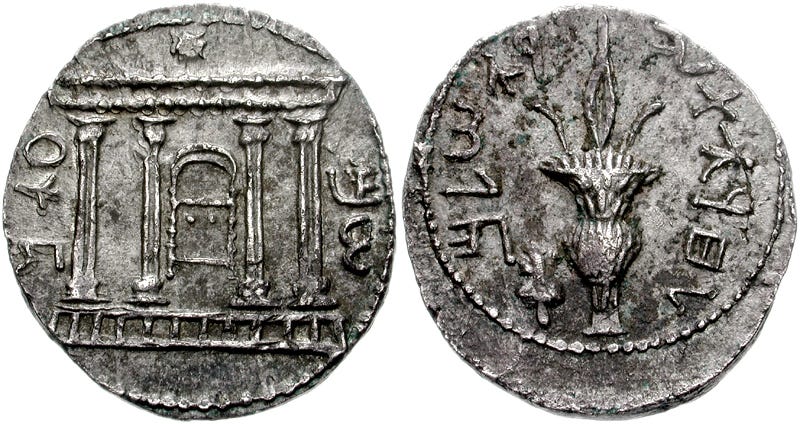Etrog Exposed: The Surprising Secrets of a Sacred Citrus
Curious Cuisine, Ancient Remedies, and Surprising Uses of Judaism's Most Fragrant Fruit
Shalom from Israel,
One of the joys of living in Israel is the cultural richness of the holidays and how they are celebrated across the vast spectrum of Jewish beliefs. Of all the holidays—and there are so, so many—Sukkot is the one that most connects me to the Jewish people and the land of Israel.
Every year, as I sit in the sukkah with my family, we are enveloped by a symphony of voices from families enjoying meals in their own sukkot throughout the neighborhood. It's funny, I generally can't stand when all the neighbors are outside and noisy at night, but on that one night of Sukkot, I choose not to be an asshole. I'm big like that.
On Sukkot there is a tradition called Ushpizin, the Aramaic word for “guests” and refers to a short prayer recited on each night of Sukkot inviting one of seven Jewish forbearers to join us in the sukkah. Welcoming guests is a universal Jewish value but even more so on Sukkot.
I’d like you welcome you as Ushpizin into a different kind of sukkah: the vibrant, ever-expanding structure of my mind. Here, ideas don't just ping-pong; they perform an intricate dance, weaving, much like the s'chach (sukkah roof) filtering sunlight. My thoughts as browser tabs – numerous, diverse, and perpetually open. They span from the ancient wisdom of the Hebrew Bible to the intellectual labyrinth of the Talmud. They leap from the practical cooking guides and esoteric medical texts penned by the great minds of Ancient Greece, the Roman Empire, and Medieval Jewry to academic articles in the Journal of Ethnopharmacology, Journal of Spatial and Organizational Dynamics and International Journal of Gastronomy and Food Science.
This mental sukkah of mine is built not with wooden beams and palm fronds, but with curiosity for the esoteric, a zest for knowledge and amazing ADHD hyperfocus.
So I wrote about the etrog. This funky-looking citrus plays a starring role in holiday observance where it's waved around with some branches as part of a ritual that's all about unity and counting your blessings.
So chag sameach and welcome. Grab a cup of sweet mint tea and enjoy your visit.
Harry
The Etrog: More Than Just a Ritual Object
The Etrog Man and Pregnant Women
"You will have beautiful smelling children," says Uzi-Eli Hezi, the Etrog Man, as he sprays etrog spray on the face of a visibly pregnant participant during one of my food tours of Jerusalem's Mahane Yehuda market years ago. This remark may sound inappropriate, but when it comes from the mouth of Jerusalem's most famous Yemenite healer, you might want to listen. Sadly, Uzi-Eli passed away a few years ago, but his legacy and the memory of his unique remedies live on. His comment is derived from a Talmudic story where the wife of King Shapur of Persia ate an etrog during pregnancy and gave birth to a daughter who was so fragrant that she was placed in front of her father on top of spices. And the Persians love their scents.
The Etrog in the Babylonian Talmud

The Babylonian Talmud also provides an intriguing glimpse into the etrog's role beyond ritual use: Ketubot 61a recounts an episode involving King Shapur, who offered an etrog to his Jewish guests, Mar Yehuda and Bati bar Tuvi. The king personally sliced the fruit with a knife before serving it, a detail that speaks volumes. This simple act underscores the fruit's role beyond religious ritual, showing its appeal as a culinary item enjoyed by both Jews and non-Jews alike. And in a Persian palace setting of all places. And cut by a king! That's some fancy fruit.
The Etrog's Journey to Jewish Symbolism
While the etrog is not specifically named in the Hebrew Bible, the phrase peri eitz hadar in Leviticus, relating to the Sukkot feast, has been interpreted as referring to the etrog. This interpretation, however, is likely inaccurate, as there's no evidence of the Jewish people having knowledge of the etrog until centuries after Leviticus was written. The Persian conquest of Israel in the sixth century BCE appears to be a turning point in the etrog's journey to becoming a Jewish symbol.
The etrog's prominence as a Jewish symbol can be confirmed by its appearance on coins during the Great Jewish Revolt (69-70 CE) and Bar Kokhba revolt (132-136 CE). These coins were minted with the inscription "For the Freedom of Jerusalem," with the etrog on one side and the façade of the Temple on the other.

Following the destruction of the Second Temple in 70 CE, Jewish communities spread throughout the world and the Diaspora created a demand for the etrog in regions where they weren't naturally grown, further spreading the cultivation of the fruit throughout the world.
The Many Names of Etrog
What we know as the etrog has long been called the Citron in English. In French, it's known as "citronnier des juifs," and in German, "Judenapfel" (a word I have been randomly screaming in an exaggerated German accent all day. Try it yourself!). It's also known by its genus and species: Citrus Medica, a name coined by "the father of taxonomy" Carl Linnaeus in the 18th century. You don't need to be a botanist to understand that this name refers to the medicinal uses of the etrog. More on this in a minute.
Culinary Uses of the Etrog
When Sukkot is over, what do people do with their etrog? There are generally three options: make a jam, make a liqueur, or shove it into the tuchus of a chicken carcass. A trifecta of bad ideas. Etrogim cultivated solely for ritualistic purposes are bred to look great, not to be eaten. They are not food grade. So make it an air freshener (it's the most fragrant of citrus!), but do not eat it.
Citron Leaves as an Aromatic
The earliest culinary use of the citron appears in Apicius, a fifth-century collection of Roman cookery recipes that mentions using the leaves as an aromatic (much like a bay leaf) in a rose wine recipe.
Ibn Razīn al-Tujībī, scholar and author of the Best of Delectable Foods and Dishes from al-Andalus and al-Maghrib (a cookbook with the best name ever), used citron leaves of the 'Utrug' variety of citron in a court bouillon for a dish of bream with honey and must. Although he was Muslim, the recipes in his cookbook represent Andalusian heritage, which had influential Jewish cultural representation.
Candied Citron: A Sweet Treat
The citron is unique in that it is prized for its thick, white rind rather than its juice. The thick albedo, the white part inside the citrus fruit (called "panne" or "bread" by the Italians) isn't bitter, making it ideal to turn into a candied fruit. The most popular way of consuming etrog is candying the peel, known as Succade. I have found many claims that the name succade may have originated from the Hebrew word sukkah, but I'm calling nonsense as there's zero evidence to back it up. It's more likely from the word succidus, Latin for "juicy" or succatum, the medieval Latin word for candied fruit.
The First Recipes
The earliest recipe for candied citron can be found in Kanz al-Fawa'id, an Egyptian text of medieval Arabic recipes for cooking, drinking, and table manners (contrast this with medieval Europeans who were known for their lack of table manners) written during the thirteenth century.
During the 9th to 12th centuries, the Arab world became the Willy Wonka Corporation of the Mediterranean. In his book Sweetness and Power: The Place of Sugar in Modern History, Sidney Mintz wrote "Wherever they went, the medieval Arabs brought with them sugar, the product and the technology of its production.” This Arab influence extended to Sicily, where the art of candying was embraced and subsequently disseminated across Europe in the 16th century, further enhancing its popularity and prominence. To this day, candied citron remains very popular in Italy.
During the Renaissance, Pope Pius V's personal chef, and the most influential chef and recipe writer of the Renaissance, Bartolomeo Scappi, was busy cooking up a storm with some serious Arab-inspired flair. His cookbook features a few zesty creations. Candied citron peel (Scorza di cedro e di melangole confette asciutte) and sweetened citron pulp (Polpa di cedro confetta asciutta) graced the papal table, while citron flowers got their moment in the spotlight too. Scappi spiced them up (Fiore de cedro conditi) and even tossed them in salads (Fiori di cedro in insalata). Scappi also included fresh citron slices in recipes for roasted turkey and pheasant, often served cold with sugar, capers, and a marinade of sugar, salt, and rosewater.
Medicinal Uses of the Etrog
As a Poison Antidote
The earliest mention of medicinal uses of the etrog among Jews can be found in the Babylonian Talmud. Rabbi Huna bar Yehuda had a sweet idea, literally: He recommended eating a "sweet etrog" filled with honey and heated on coals as a remedy for snake bites or water contaminated by snake venom.
The medieval medical mastermind Maimonides, in his treatise On Poisons and the Protection Against Lethal Drugs, wrote that the etrog seeds could serve as an antidote to various toxins, regardless of whether they were ingested (see above: water contaminated with venom) or introduced through bites. In his writing, Maimonides recommended a dosage of 1-2 mithqals (an ancient unit of weight, the equivalent of approximately 4.7 grams ) of ground etrog seeds, to be mixed with either wine or cold water before ingesting. L'Chaim.
Rabbi Huna bar Yehuda and Maimonides' ideas weren't original, but expansions on earlier writings of Greek botanist Theophrastus, who wrote that the Persian apple, (citron) when given with wine, induces vomiting and expels poison. There's also a story recalled by Athenaeus of Naucratis where criminals who were sentenced to death by being thrown to asps in Egypt. A woman compassionately offered them citrons to eat. Those who partook, survived, while those who didn't, perished. Maimonides' specific remedy is directly influenced by the writings of Persian physician, DJ Avicenna. He wasn’t actually a DJ, it just felt right making him one.
Migraines
Many remedies using elements of the citron can be found in Qarabadin-e-Kabir, a compilation of traditional Persian remedies and functional foods used for treating various diseases and ailments. This includes a migraine citron syrup called Sharbat-e-Balang, which works based on a connection between the digestive tract and the brain. Back in 2015, doctors and scientists at Shiraz University of Medical Sciences held a clinical trial and published "Effect of a traditional syrup from Citrus medica L. fruit juice on migraine headache” where they concluded, that yes, indeed, Citron syrup as a traditional Persian remedy can be suggested as an effective treatment for decreasing pain intensity and duration of attacks in migraine headache. It’s been peer reviewed too.
Bad Breath, Psoriasis, and Rheumatic Pain
Other uses include treating halitosis (the aforementioned Etrog Man developed a mouth spray for this purpose), treatment of psoriasis and rheumatic pain (he developed a cream for this too).
Fertility and Childbirth, Obviously
The etrog is a breast and the lulav is a penis. Jewish and Islamic sources over the centuries have mentioned the etrog as a fertility improver for men, boosting sperm count and enhancing sexual performance, while the Greek physician Dioscorides wrote that women consumed citron to suppress their desires. This contrasts with the belief that citron enhanced male potency.
Pre-modern European traditions attributed healing powers to the etrog, particularly for women during childbirth. Some communities believed that biting the tip of the etrog (pitam) would enhance fertility, while others macerated it in sugar and offered it to women in labor or those experiencing general illness among the community. Others believed that eating the pitam ensured the birth of a male child.
Our Greek medical practitioners mentioned above recommended etrog, specifically its seeds, to pregnant women experiencing nausea. Do not do this. This does not vibe with modern medicine.
My Two Favorite Uses
Warding Off Evil Spirits
Rabbi Haim Palachi (1788–1868) recommended reciting a blessing over citron cooked in honey and sugar on the eve of Tu B'Shvat as protection against evil spirits. Definitely do this one.
Curing Muteness
In the Sefer Refuot, the earliest known medical book in Hebrew from the early medieval period, there's a remedy for muteness that involves placing a piece of citron rind in the mouth. This remedy, lacking any scientific basis or common sense, is insane. Try it on one of your most quiet friends.
Other Uses
In Ancient Greece and China (where the citron originates), the citron was used as mothballs. The etrog doesn't rot like other citrus; it dries out. They would place the dried etrog among their clothing to keep the moths away.
It was believed to cure seasickness and treat epilepsy.
Pliny the Elder, author of Historia Naturalis” (Natural History), a Roman encyclopedia of natural science that spanned thirty-seven books, suggested applying a mixture of citron juice and vinegar to the skin to remove freckles.
It was thought to ward off snakes.
Pliny the Elder also wrote that it makes a room smell nice (air freshener).
In India, branches of the citron tree are used as walking-sticks.
Rabbi Palachi also recommended distilling etrog water with mastic tree resin to combat cholera.
It is important to note that the medicinal and cosmetic uses of citron and etrog mentioned here are not scientifically proven and should not be followed under any circumstances. Though I want to reiterate that you should definitely try warding off evil spirits as recommended by Rabbi Haim Palachi.
I’d just stick with making an air freshener. You can find the instructions here
⌇⋰ Website
⌇⋰ Email : harrysbaked@gmail.com or respond to this email, I love to hear from you.







